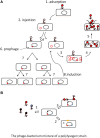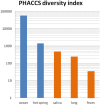Bacteriophages: an underestimated role in human and animal health?
- PMID: 24734220
- PMCID: PMC3975094
- DOI: 10.3389/fcimb.2014.00039
Bacteriophages: an underestimated role in human and animal health?
Abstract
Metagenomic approaches applied to viruses have highlighted their prevalence in almost all microbial ecosystems investigated. In all ecosystems, notably those associated with humans or animals, the viral fraction is dominated by bacteriophages. Whether they contribute to dysbiosis, i.e., the departure from microbiota composition in symbiosis at equilibrium and entry into a state favoring human or animal disease is unknown at present. This review summarizes what has been learnt on phages associated with human and animal microbiota, and focuses on examples illustrating the several ways by which phages may contribute to a shift to pathogenesis, either by modifying population equilibrium, by horizontal transfer, or by modulating immunity.
Keywords: biological weapon; community shuffling; digestive tract; horizontal transfer; virome.
Figures



References
-
- Alexopoulos L. G., Saez-Rodriguez J., Cosgrove B. D., Lauffenburger D. A., Sorger P. K. (2010). Networks inferred from biochemical data reveal profound differences in toll-like receptor and inflammatory signaling between normal and transformed hepatocytes. Mol. Cell. Proteom. 9, 1849–1865 10.1074/mcp.M110.000406 - DOI - PMC - PubMed
Publication types
MeSH terms
LinkOut - more resources
Full Text Sources
Other Literature Sources

